Level Up Your Gigs: Amplifying Keyboards
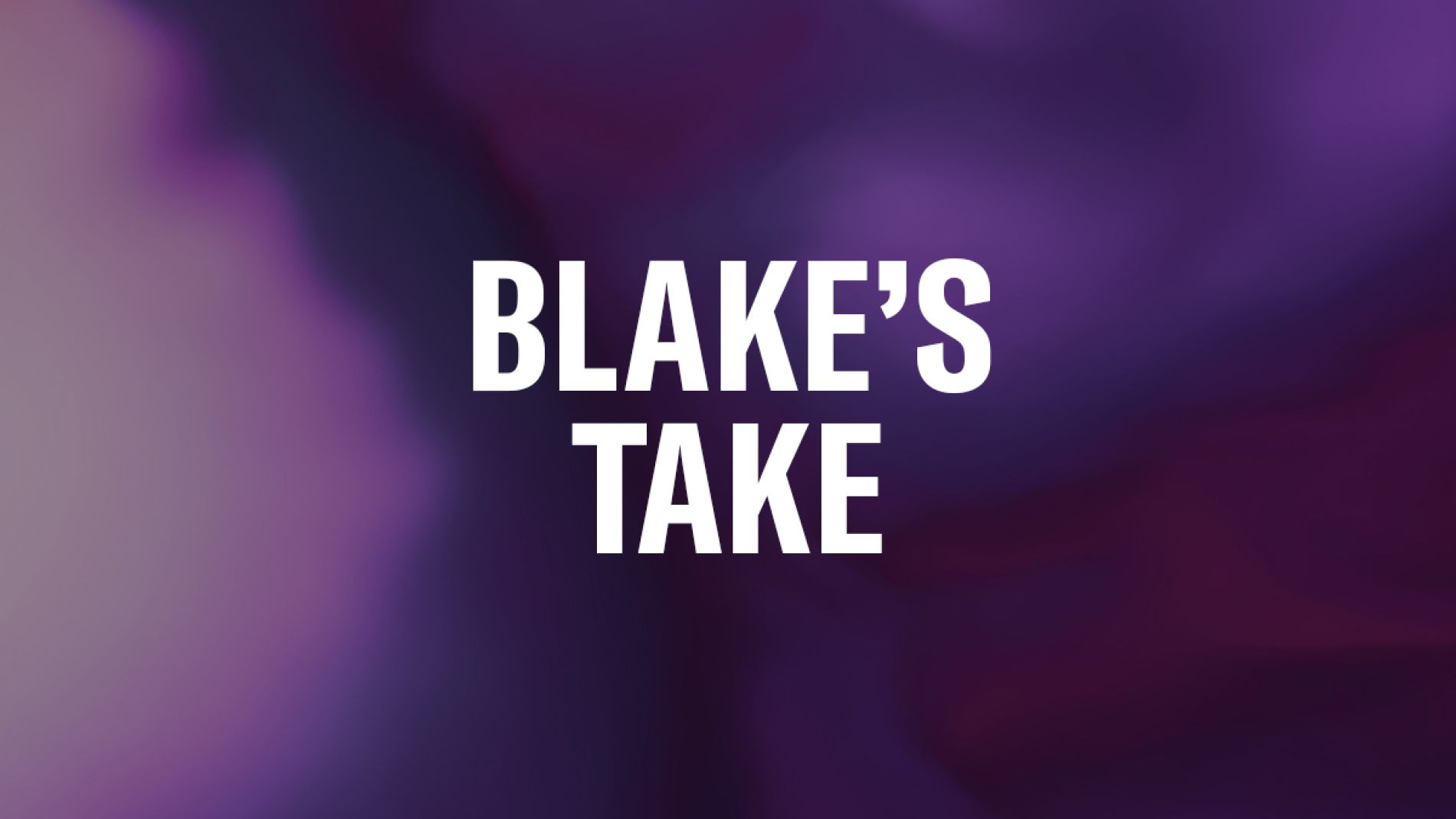
In this article I’ll revisit a few of these best practices. There are some great insights in is Howard Massey’s Audio 101: Gain Staging article. He covers the fundamentals of sound reinforcement. I recommend looking at this article for technical insights into proper gain staging.
The Virtues of Stereo Sound
Stereophonic sound is the standard for audio playback and recording. Stereo monitoring enhances the playing and listening experience. The only way to experience stereo imaging with two speakers. This makes sense when buying a set of headphones, a home audio system or setting up a home studio. Most people wouldn’t buy a headphone missing one ear cup or a single speaker when purchasing a sound system. We should feel the same way about our keyboard setup. Stereo amplification delivers the best sound from synthesizers, stage pianos and stage keyboards.
My Keyboard Amplification Journey
When I first started gigging, I realized I needed something to amplify my keyboard rig. It made sense to look for a keyboard amplifier, so I ended up buying a giant amplifier presumably designed for keyboards. I didn’t know any better: It said “keyboard amplifier” so it must be what I needed.
Getting a good sound out of this amplifier was impossible. For one thing it was just a glorified bass amp, with a large woofer and tiny tweeters. There was no midrange, lots of bass, blistering high end and no definition. I quickly figured out that I needed something better, so I exchanged this for a small PA system consisting of a powered mixer and two speakers. Immediately the sound was much better, and I had the added flexibility a PA offers. I could offer microphones to singers and horn players, drop a mic in front of an amplifier or acoustic piano and play background music from a portable audio device during breaks.
When I first got this PA my keyboard rig was a Yamaha CP-70 and DX-7 and an electric piano. It was quite a heavy rig! Even though all the instruments lacked stereo outputs they sounded much better through the PA system. I should mention that my first PA wasn’t stereo. There were no pan controls to move the signal to the left or right in a stereo field but the improved EQ and speakers sounded better.
Around this time, the first stereo outputs started appearing on professional keyboards. This evolution made sense as stereo sampling and stereo effects entered the picture. Over the past 20+ years all Yamaha synthesizers feature a at least one set stereo outputs. Stereo delivers a realistic sense of depth and space. I ended up selling my mono rig and replaced it with a Yamaha PF-80 Electronic Piano and a few other synthesizers, all with stereo outputs. Soon after I purchased a pair of powered speakers and a small stereo mixer. Over the years I’ve upgraded keyboards and sound systems, but from the late 80s to now I’ve been in stereo.
When someone connects a modern instrument using only the “L” output of a stereo pair to a keyboard amplifier sitting on the floor, the audio quality is going to suffer. The depth and details get lost along with the stereo image.
A final anecdote: In the mid 2000s, I played a gig with a MOTIF ES8 connected to a small MG mixer and a pair of MS150 powered speakers. When the band went on break a member of the audience approached and said this: “Your MOTIF sounds amazing! I have the same instrument and I can’t get the same quality of sound you’re getting. What is your secret?”. People have asked me this question in different ways, and I always answer with this question: “How are you amplifying your keyboard?”. The answer is almost always “I have a single keyboard amp”, or “I’m using my buddies guitar amp”.
I have different setups for different gigs, but one thing remains the same: I always amplify my keyboards in stereo. Some gigs I’ll only need the keyboard, supporting gear (keyboard stand, speaker stands, drum throne for me to sit on, pedals, cables) and speakers. Gigs with more musicians may require a mixer and a second set of speakers if I want to run mains and monitors. For this reason, I have a small PA system featuring a set of DXR10 powered speakers, a set of DSR112 powered speakers and an MG06x or MG10xu. But the key point is I ALWAYS have two speakers. Stereo is that important. Below are a few scenarios.
Venues without a PA system
Most of my gigs are in small clubs that don’t have a PA system, so I’ll bring my own system and scale as needed. What I bring depends on my role: I may be a solo pianist, a pianist in a trio with bass and drums, or in a small ensemble with 4-6 players (trio with a guitar, horns, vocalist, etc). Below is how I set up my sound system in each of those scenarios.
Solo Piano: Most of the time a solo pianist is background music in a small bar, restaurant or coffee shop. In these situations, I bring my keyboard (CP88 or YC88), my supporting gear and my two DXR10 powered speakers. I’ll often set up my speakers on the floor in monitor position. This is slick feature of the DXR10, 12 and 15: They can be configured sideways as monitors and lean back at 50º. They also have a DSP MONITOR setting that cuts low frequency rumble. Check it out:
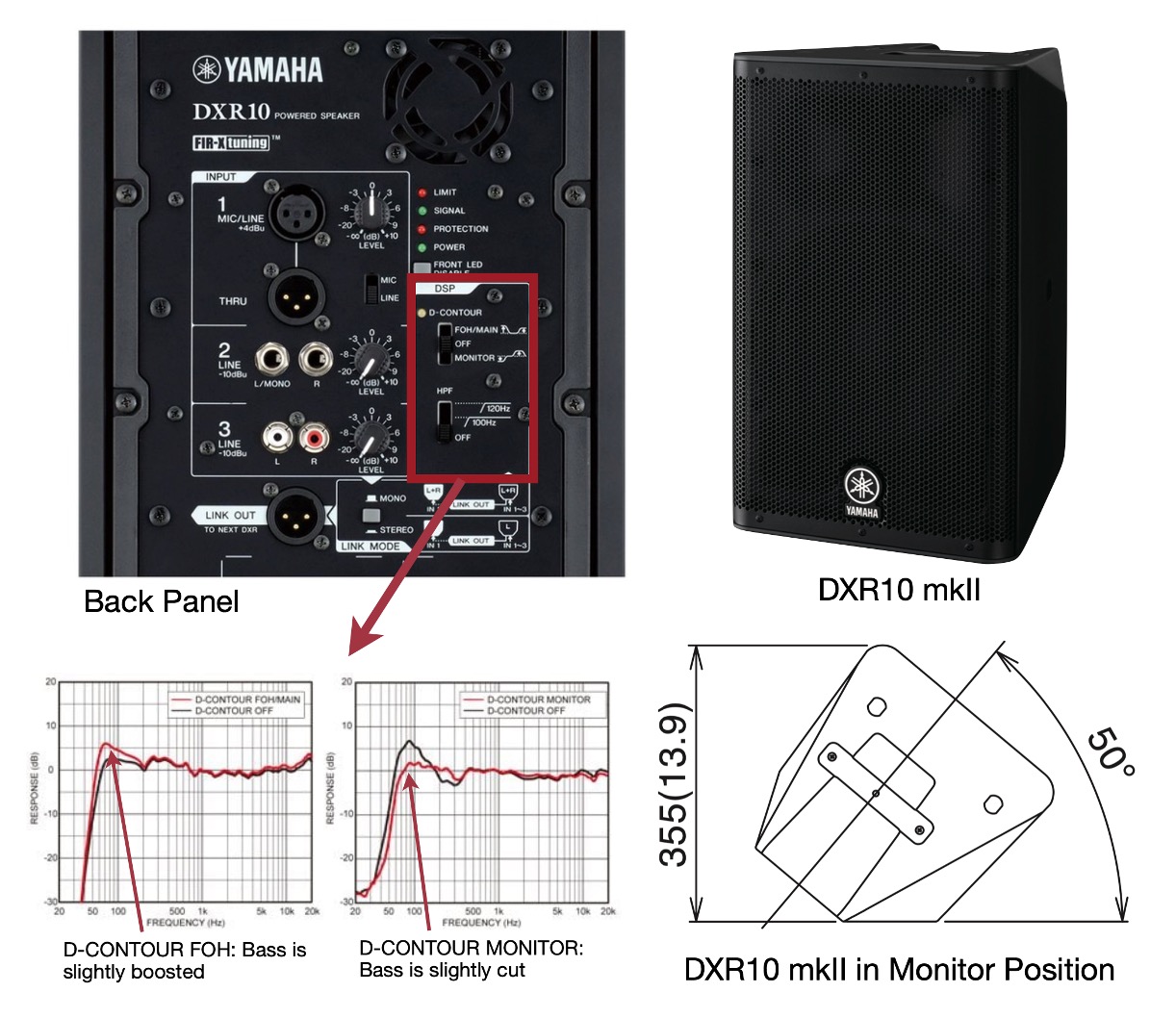
I’ll set the speakers up on either side of the keyboard. This monitor position works great because it’s stereo, I can hear it and it isn’t too loud for customers wanting to chat.
In those rare instances where I am not background music, I’ll add my speaker stands, set the D-CONTOUR to OFF or FOH depending on the room and position the DXR10s in the second set of holes that angle the speakers down 7º. This points the speaker at the audience (not over their heads) and adds clarity to the sound. This is another cool feature of the DXR speaker:
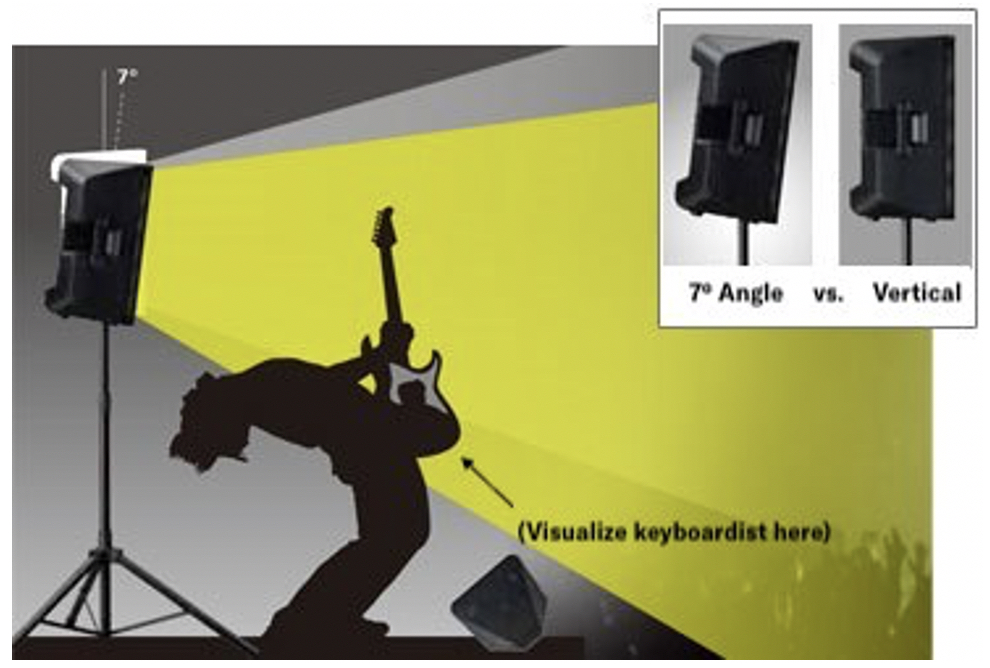
Piano Trio: In a piano trio I’ll set up the DXR10s on a stand and set them in the 7º position. I like to set up with the bassist in the middle, and I’ll set one speaker between the drummer and the bassist and the other behind me and off to the side:
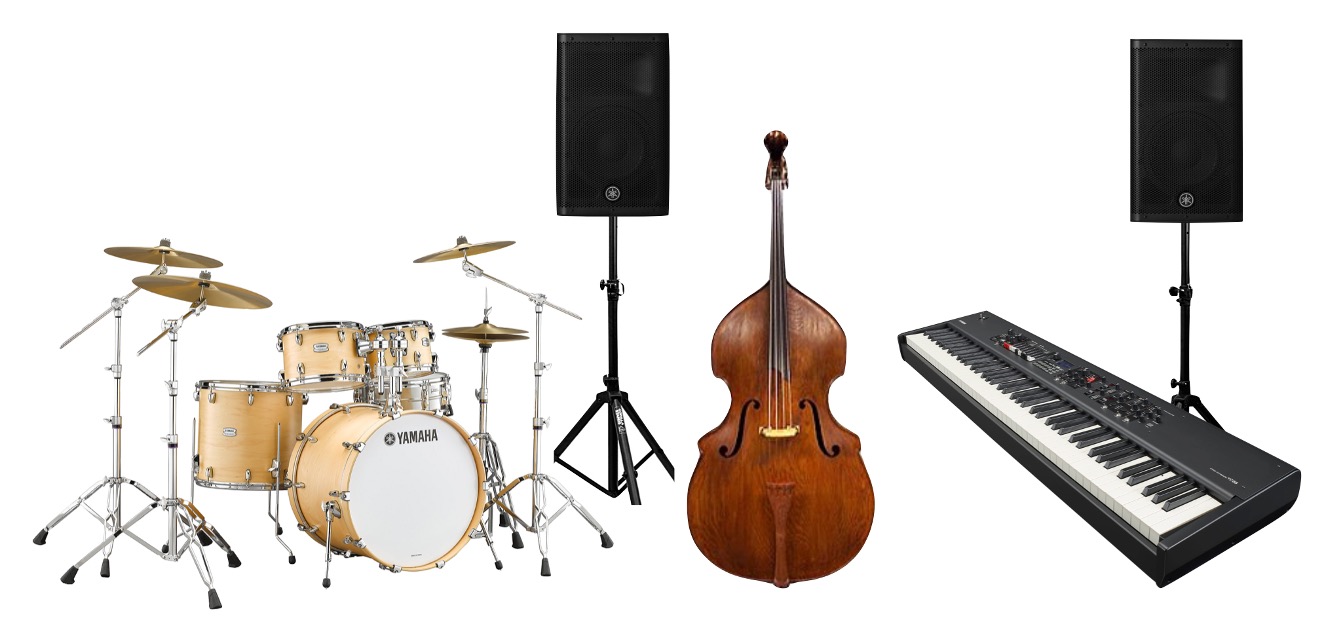
Quartet, Quintet, Vocals: Same system as the piano trio. In a larger venue, I’ll add my larger DSR112s as the main speakers and set up my DXR10s in the monitor position with the D-CONTOUR set to MONITOR. I’ll use the MG10xu mixer since it has separate controls for main STEREO OUT (in red) and MONITOR OUT (in white):
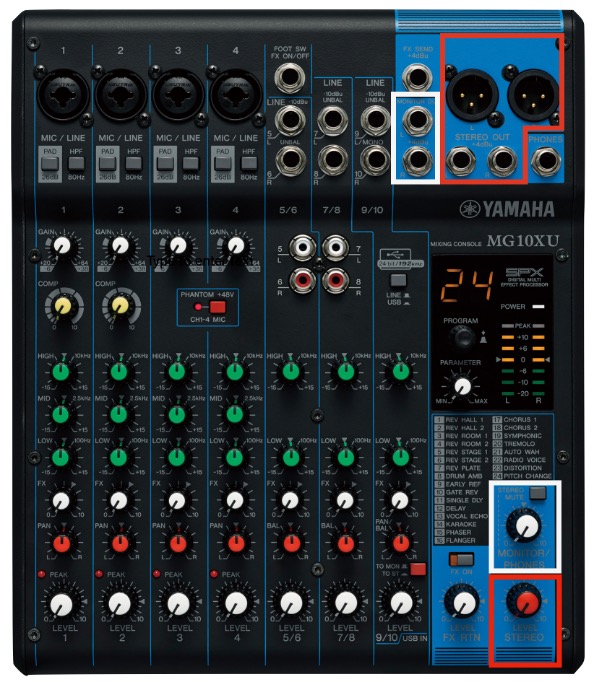
Venues with Installed Sound Reinforcement
Small Venues with a Basic PA: When I’m playing a club with a PA system, I almost always end up setting up my own monitoring system. Generally, I find that even in a small venue they’ll have reasonable front of house amplification with two or more speakers either flown from the ceiling or set up on stands. Sometimes there are two floor wedges for monitoring, but that’s not a guarantee. Systems are usually a powered mixer with passive speakers or a small portable PA. In these situations, I’ll set up my DXR10 system for personal stereo monitoring and give the house PA a stereo feed. For this the MG06x works great. Check it out:
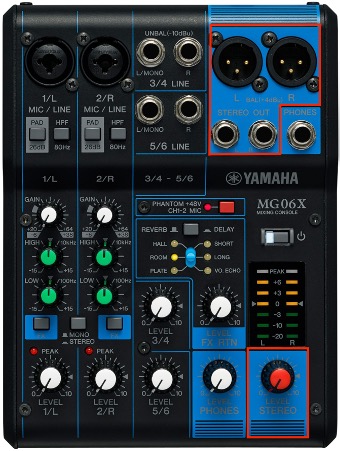
Larger Venue with Larger PA: Nowadays, most if not all venues have digital mixers with flexible and plentiful monitoring options. This means when I show up, I’ll often find a stereo direct box waiting for me. Take a look at this outdoor gig I recently played.
When I showed up there was a stereo direct box waiting for me. The monitors were configured as stereo pairs. I could hear myself and the band. There was no need in this situation to set up a personal monitoring system (although I was prepared…my DXR10 system was in the car!). Having great sound for yourself and the audience is the goal and in this situation that was achieved.
Getting the best sound possible for yourself and the audience should be the goal in every situation. Stereo sound is a fundamental part of great keyboard amplification. This, along with proper gain staging and reliable, good sounding amplification are also important. Once you’ve experienced great keyboard amplification nothing else will suffice. I am planning on going to a rehearsal today with a jazz quartet. Even in a rehearsal I won’t comprise. I’ll bring both DXR10s because I know that I’ll play better and the band will sound better. I’ve mentioned a few products in this article to consider for a solid keyboard amplification set up. Here they are again along with a few additional solutions:
Mixers
MG Series: Great sound, a host of sizes to choose, solid metal chassis and remarkably affordable. MG Series are a great solution!
TF Rack: This compact rack-mount version of the TF Series digital mixing consoles offers great sound and total recall. For keyboardists needing more inputs, powerful digital mixing, great on-board effects and more, this is a great solution. This is what we use at trade shows because of the total recall, generous inputs, flexible routing and connectivity expansion via the Dante Tio1608-D stagebox.
PA Systems
StagePas 400BT/600BT: This all-in-one stereo PA system is easy to move around and set up, comes in 400- or 600-watt sizes, sounds great, is easy to use, and includes Bluetooth audio streaming. You can use a Bluetooth enabled device like a smartphone for backing tracks…wirelessly!
EMX7/9 and Club Series: This type of set up has been around for many years. This modern version of the traditional powered mixer/passive speaker set up sounds great and has plenty of power.
Powered Speakers
Yamaha has three lines of great powered speakers for any budget.
Good: DBR Series. The DBR Series come in three different sizes (10/12/15), are lightweight and sound great.
Better: DXR mkII Series. This series come in four different sizes (8/10/12/15), have more power and include higher level components like a Neodymium compression driver that decreases the weight without compromising sound quality.
Best: DZR Series. The flagship of the powered speaker line has selectable DSP settings via a small screen on the back, Dante I/O, and 2000 watts of power.
Want to share your thoughts/comments/questions? Join the conversation on the Forum here.
Keep Reading
© 2025 Yamaha Corporation of America and Yamaha Corporation. All rights reserved. Terms of Use | Privacy Policy | Contact Us